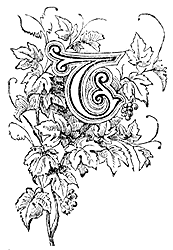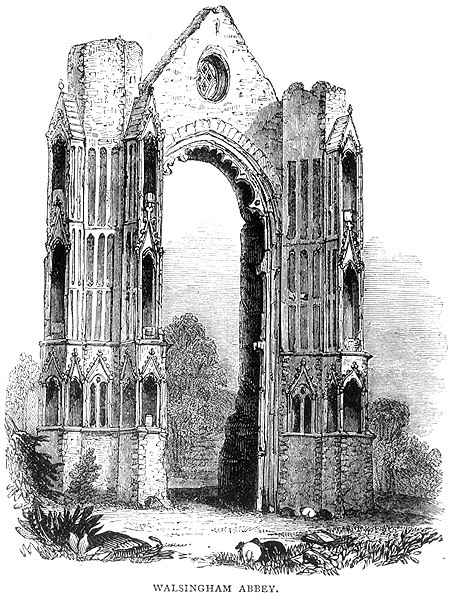 |

HE chapel or shrine of our Lady of Walsingham was, in its day, one of the richest in the world. Roger Ascham, when visiting Cologne in 1550, says, "The Three Kings" - the famous Cathedral of the Magi - "be not so rich, I believe, as was the Lady at Walsingham."
The number of pilgrims who yearly went to Walsingham was enormous Thither penitents hurried for absolution, or persons in trouble to pray for aid. The image of the Virgin in the small chapel, "in all respects like to the Santa Casa at Nazareth, where the Virgin was saluted by the angel Gabriel," was the chief attraction; pilgrimages to this shrine exceeded those made to St Thomas a Becket's, and large endowments and costly gifts enriched the priory.
Pilgrims from all nations came to this sacred place, and several of our English sovereigns visited it. Even Henry VIII., at the commencement of his reign, with Queen Katherine, paid his devotions here.
Spelman, the antiquary, tells us that the king walked to Walsingham barefoot from Baseham, a distance of about three miles, it being a condition that if the pilgrim would benefit by his pilgrimage it must be made barefooted. Henry presented a valuable necklace to the image. It is supposed that the riches and splendour of Walsingham greatly impressed the king's mind, and tempted him to precipitate its fall. Cromwell seized the image and burned it at Chelsea. We wonder what became of the necklace!
The monks persuaded the people that the Milky Way in the heavens was a symbol of the road to this shrine, and the populace took to calling the starry road "the Walsingham way."
Erasmus visited Walsingham in 1511, and has described it in a mocking dialogue.

The pilgrims entered the sacred precincts by a low, narrow wicket, which was made purposely difficult to pass, as a precaution against robberies from the shrine. On the gate in which the little wicket opened was nailed a copper image of a knight on horseback, whose miraculous preservation on the spot by the Virgin was one of the legends of the place. To the east of the gate was a small chapel where any pilgrim who liked to pay for it was allowed to kiss a gigantic bone, said to have been the finger bone of St. Peter! After this he was conducted to a thatched building enclosing two wells, which had the repute of curing headaches and indigestion; and also for the miraculous power of insuring to the pilgrim whatever wish he might make while drinking the water. The building itself was said to have been transported there miraculously from the north in a deep snow-storm; and as a proof of it an old bear skin attached to one of the beams was pointed out to the visitor.
In the Chapel of the Virgin the celebrated statue of Our Lady stood on the right of the altar. The chapel had only artificial light from numbers of tapers which dimly revealed the sacred image surrounded by gold and jewels. The air was strongly perfumed with incense. The pilgrim knelt on the steps of the altar, offered up his prayer and laid his offering on them and passed on. A priest stood in readiness to take the offering, "lest," we are told, "the next comer might steal it while depositing his own offering."
The Virgin and her Son bowed their heads, and Erasmus says it appeared as if they gave them a nod of approbation. Amongst the treasures of Walsingham were a silver statue on horseback, of Bartholomew, Lord Burghersh, ordered by his will in 1396 to be offered to Our Lady; and a kneeling figure of Henry VII. in silver gilt, given during his lifetime. The visitors at the Dissolution took possession of all these treasures for the king.
There are some fine remains of the abbey: a richly ornamented door that may have formed the east end of the church; the western entrance gateway to the monastery; the walls with windows and arches of the refectory; a Norman arch, with zigzag mouldings, remain. The joint excavations of Mr. H. I. L. Warner and Mr. Harrod have brought to light the west end of the church of the early decorated or early English period. The refectory and dormitory crypt are pure decorated; the west end has a noble window. The east end is early perpendicular. In the choir are a red and yellow glazed tile pavement, buttresses, and crypt.
|
 |